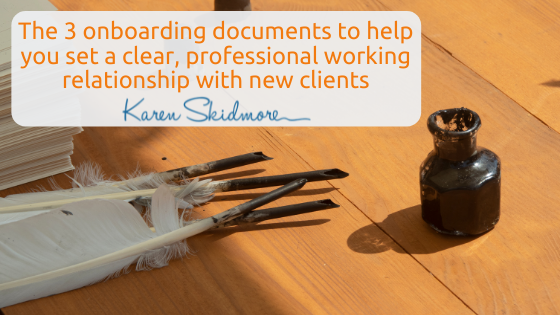I’m writing about boundaries this month; those often invisible lines that we need to have to protect and fuel our time and energy. Last week I wrote about the 4 work boundaries to increasing profitability and avoiding burnout. This week, I want to shine the light on how clear your legal and professional working relationship needs are set with your clients.
When so much attention is given to sales and marketing, the legal processes and terms of engagement of a new client starting to work with you are often overlooked. For some of you, it’s a lack of awareness. After all, what you don’t know, you don’t know. For others, it can feel dull, confusing or perhaps a little scary.
And I’m here to tell you that none of that needs to happen.
There’s no shame in not knowing what you aren’t even aware of. And if you have been shying away from this area of your business (or even burying your head in the sand!), then I want you to know that it is far easier and simpler than you may be making it out to be.
In this week’s article, I have broken down the three documents to use during your onboarding process with new clients that set up your Power Partnership working relationship. With these in place, you will find a real shift in your business, no matter what it is that you actually do with them or for them.
First of all, what is a Power Partnership™?
Partnership Power™ is the phrase that I use to teach my clients how to sell and work with clients from a place of equal power.
When you let your work and personal boundaries slip, you start to give up your power and this can lead to some clients beginning to take liberties with you. Sometimes this shows up as simply not turning up to meetings on time or not giving you what you need in order to do your work, such as completed questionnaires. With others, they may start asking for discounts or add-ons to what you’ve already agreed.
When you start saying ‘no problem’ to them, you allow your power to shift away from you even more and the relationship has the danger of quickly becoming toxic; behaviour such as unpaid invoices going unpaid to start or cancelling meetings without notice.
But take too much power over your clients, dictate your terms and not show any flexibility or compassion when needed, you will come across as arrogant, cold or dismissive of their needs. This, of course, would start pushing away clients and your business will suffer.
Setting clear working relationship boundaries doesn’t mean you need to become Queen Bitch. Putting the right legal and terms of engagement in place is about creating the space and container for both and your client to work side by side, in partnership and in service with each other, rather than you becoming the servant.
Let’s dive into the three things that will give you this container.
1) Terms of Service
Whatever you sell, your clients have to be aware of the parameters of your professional working relationship; basically, getting clear on what it is that they’ve actually bought.
If you don’t set the rules at the start, your client won’t know when they are stepping over the mark or requesting something that you can’t or don’t want to deliver on. Remember you are in service to them, rather than taking on a servant role.
The specifics of your working relationship need to include:
- Exact outline of your service and/or programme. If you’ve done this via a proposal, then this should be pretty clear. But if you’ve sold via a conversation or click on your website, then having a welcome pack or email to confirm what it is that your client is receiving from you, is critical. You may have told them on the phone the details or have it listed on your website, but your clients are human; they won’t have heard or read every detail so it’s important that you clarify this at the start of your working relationship to ensure their expectations are met and they is no ambiguity on what was on offer.
- Cancellation policy. In the UK, anything sold that your client hasn’t seen in person (which is anything you sell, unless you have an in-person gallery or shop that you are selling from), gives them the right to a 14 day cooling off period. But what happens if they no-show or they want to cancel a contract or workshop? How do you deal with emergency situations when they genuinely can’t keep their agreed time? Is there a charge in place when they don’t? If you are in any doubt that you need to have clear cancellation or postponement clauses in your terms, then I always recommend you take inspiration from your dentist; you’d never be able to cancel an appointment at the last minute without a financial penalty. Why should you be any different?
- Confidentiality. Is this important to highlight in your client work? Do they need reassurance of the level of confidentiality and how you will manage this?
- Payment terms. When do you expect payment and how? It’s not good enough to let your clients pay you when it suits them. You either set up a pay-before-we-start-work-together process or invoice with 5 days payment terms, slightly longer perhaps if you are dealing with a finance team in an organisation, but certainly not 90 days which I’ve seen one of my own clients feel obligated to agree to.
These terms of service don’t need to be long and legal. You can create a very personable welcome pack or letter that highlights the promise you are making to your client and the level of service you are giving them, without lots of small print.
For those of you who work directly as a coach, consultant, trainer or therapist, I do recommend you get your clients to sign one, rather than just email them a copy for reference, before you start working together because it means they’ve read it and acknowledged how your relationship is going to work. There are some good, inexpensive options such as Hellosign that make this signing process work easily online.
2) Terms and conditions
Technically, there’s very little difference between a Terms of Service and a Terms and Conditions. Many businesses will refer their clients to one document and contract.
But I like to split them apart because I find that many of you reading my articles run businesses that involve personal relationships with your clients. Simply having a long, legal contract as your only form of service or programme confirmation, can be rather daunting for your client. They may even be scared off or feel it’s all rather too serious if this is their first time working with someone like you. On the other end of the scale, only having a Terms of Service welcome pack can mean you miss out on some important legal points that protect both you and your clients.
So for clarity, I am referring to your Terms of Service as a read-friendly document that confirms your client working relationship; a welcome pack or letter or proposal. Your Terms and Conditions is a statement of both you and your clients’ legal rights. This is the document that is needed to protect you both in case of a breakdown of your working relationship, unforeseen circumstances that mean you may not be able to deliver what you’ve sold and cover things such as IP, professional indemnity and data protection.
Now I am sure you would never want or even imagine a breakdown of a working relationship. But the truth is that it happens. And when it does happen, it usually happens at the worst possible time. So it is critical that you have clear and legal terms and conditions set up for your business and have them both listed on your website, and have them sent to your clients at the start of the working relationship.
If you are a UK Business and want some well written templates to work from, then I can highly recommend The Small Business Legal Academy which is where I’ve got all my contracts and terms of service documents from.
https://smallbusinesslegalacademy.co.uk/sbla/
(Please note: the above link is an affiliate link and if you make a purchase, I will receive a small commission. I recommend this service because it’s something that I have already purchased, use in my own business and wholeheartedly recommend.)
3) Fair Play Agreement
This third document may be overkill for some of you, but for those of you who are about to embark on a long term working relationship or consultancy project, then a Fair Play Agreement document can be a really useful addition to your onboarding process.
I have to give credit to one of my clients for this name; Jon Norton from http://www.barefootaccounting.co.uk/ came up with this name to use in his accountancy practice and I love it. You, of course, can come up with your own name and version.
What this document gives your client is a clear outline of what you both agree to do for each other to enable a successful outcome. It is particularly useful for professional services, consultants or design companies who have used a proposal to confirm the exact nature of the project or contract, and then want to highlight some key working practices during the onboarding process.
This may include some of the following:
- Support times and access to you. How do your clients reach you whilst working with you? If you don’t want them calling you on your mobile number, why do you have it on your business card or email signature? What response time do you promise for emails or phone messages?
- Information from the client. What ‘homework’ or information do you expect your client to give you by when? If you are working to tight deadlines or managing a design project for them, and you can only deliver based on what your client gives, being clear on what you need and when, will help prevent project creep or any blame that you are at fault. Rather than have to become Queen Bitch and quote any legal obligations, you can use this agreement to keep in your Power Partnership.
- Expectations of how people are treated. You may have an assistant or a number of associates that will work with your client, so it may be that you want to ensure the right level of trust and respect is given to your team members.
Although not a legal document, it is something that I would recommend asking your client to sign, as above with your Terms of Service.
Having all three of these documents in place not only protect you and your client, but create a strong set of working relationship boundaries. Each time I help our clients put these in place in their business, there is a visible difference to the way they work within weeks.
Yes, they can take some thinking out. But do the work and you have a clear and professional onboarding process that sets the tone for a sustainable and profitable working relationship.
And as a final note, these aren’t just to be used with your new clients. If you need to get some (or all!) of your clients realigned with your new working relationship boundaries, then communicating these with them will only show you in better professional light. They set the tone for working together sustainably in the future, and can always be a great reason for bringing some more painful clients to the end 😉
Let me know what you end up putting in place and what impact these documents have on your business.
Until next time, do less, be more, play bigger.








